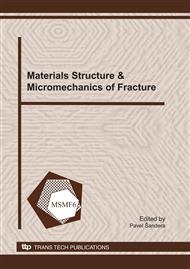[1]
M. Rogante, P. Mikula and M. Vrána, Surf. Coat. Techn., 204 (2009), p.650.
Google Scholar
[2]
A. Scrivani, S. Ianelli, A. Rossi, R. Groppetti, F. Casadei and G. Rizzi, Wear 250 (2001), p.107.
DOI: 10.1016/s0043-1648(01)00621-4
Google Scholar
[3]
A.A. Samad, E. Lugscheider, K. Bobzin and M. Maes, in: Proc. Int. Thermal Spray Conf. 2004, Protective Coatings against Wear and Erosion I, DVS-Verlag GmbH, Düsseldorf (2004), p.1.
Google Scholar
[4]
K. Tani and A. Nakahira, in: Proc. Int. Thermal Spray Conf. 2004, Applications V, DVS-Verlag GmbH, Düsseldorf (2004), p.18.
Google Scholar
[5]
R. Winkler, F. Bültmann, S. Hartmann and H. Burkard, in: Proc. Int. Thermal Spray Conf. 2003, edited by C. Moreau and B. Marple, ASM International, USA (2003).
DOI: 10.31399/asm.cp.itsc2003p0149
Google Scholar
[6]
M.R. Dorfman, Adv. Mater. Processes, 160/10 (2002), p.66.
Google Scholar
[7]
L. Li, A. Gouldstone and S. Sampath, in: Proc. Int. Thermal Spray Conf. 2004, DVS-Verlag GmbH, Düsseldorf (2004).
Google Scholar
[8]
B.S. Yilbas, A.F.M. Arif and M.A. Gondal, J. Mater. Process. Technol. 164/165 (2005), p.954.
Google Scholar
[9]
T.C. Totemeier, R.N. Wright and W.D. Swank, Metall. Mat. Trans. A, 35A (2004), p.1807.
Google Scholar
[10]
M. Rogante, in: Proc. 1st Italian Workshop for Industry Industrial Applications of Neutron Techniques, Civitanova Marche, Italy, 12-14 June 2008, edited by Rogante Engineering (2008).
Google Scholar
[11]
I. C. Noyan and J. B. Cohen, in: Residual Stress - Measurement by Diffraction and Interpretation, Springer-Verlag, NY (1987).
Google Scholar
[12]
M. A. M. Bourke, Ph. D. thesis, Imperial College, London (1990).
Google Scholar
[13]
M. Rogante, Ph. D. thesis, University of Bologna (1999).
Google Scholar
[14]
A.J. Allen, M.T. Hutchings, C.G. Windsor and C. Andreani, Adv. Phys., 34 (1985), p.445.
Google Scholar
[15]
B.D. Cullity and S.R. Stock, in: Elements of X-ray Diffraction, edited by Prentice Hall (2001).
Google Scholar
[16]
J. Pina, A. Dias and J.L. Lebrun, Mater. Sci. Eng., A 347 (2003), p.21.
Google Scholar
[17]
G. Bolelli, L. Lusvarghi, T. Varis, E. Turunen, M. Leoni, P. Scardi, C. L. Azanza-Ricardo and M. Barletta, Surf. Coat. Technol., 202/19 (2008), p.4810.
DOI: 10.1016/j.surfcoat.2008.04.066
Google Scholar
[18]
M. Gelfi, E. Bontempi, R. Roberti and L.E. Depero, Acta Materialia, 52 (2004), p.583.
Google Scholar
[19]
N.R. Shankar, H. Herman, S.P. Singhal and C.C. Berndt, Thin Solid Films, 119/2, (1984), p.159.
Google Scholar
[20]
M. Ceretti , H. Michaud, M. Perrin and A. Lodini, Exper. Techn., 19/3 (1995), p.17.
Google Scholar
[21]
A. Sahiner, D. Wittmer and M. Sweeney, Nucl. Instr. and Meth. B, 133 (1997), p.73.
Google Scholar
[22]
O. Kesler, J. Matejicek, S. Sampath, S. Suresh, T. Gnaeupel-Herold, P.C. Brand and H.J. Prask, Mat. Sci. Eng. A257 (1998), p.215.
DOI: 10.1016/s0921-5093(98)00860-0
Google Scholar
[23]
J. Dubský, J. Matějíček, H.J. Prask and T. Gnäupel-Herold, Mat. Sci. Forum, 404-407 (2002), p.419.
DOI: 10.4028/www.scientific.net/msf.404-407.419
Google Scholar
[24]
T. Keller, N. Margadant, T. Pirling, M.J. Riegert-Escribano and W. Wagner, Mat. Sci. & Eng. A, 373 (2004), p.33.
Google Scholar
[25]
L. Li, A. Vaidya, T. Streibl, S. Sampath, A. Gouldstone, V. Luzin and H.J. Prask, Mat. Sci. Forum, 490-491 (2005), p.607.
DOI: 10.4028/www.scientific.net/msf.490-491.607
Google Scholar
[26]
R. Ahmed, H. Yu, S. Stewart, L. Edwards and J.R. Santisteban, J. Trib. 129/2 (2007), p.411.
Google Scholar


